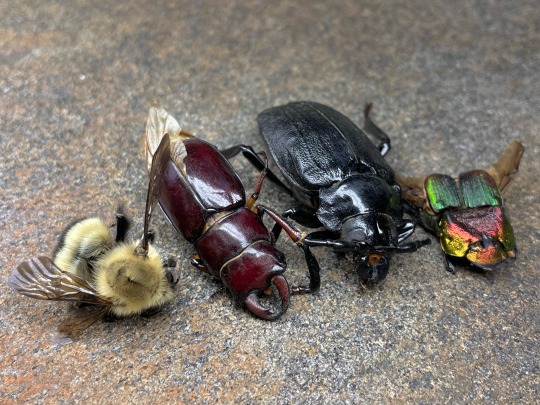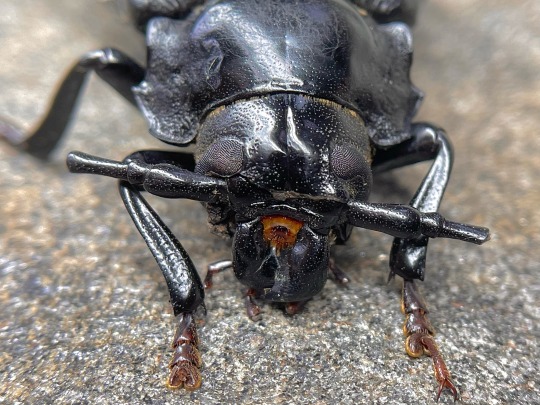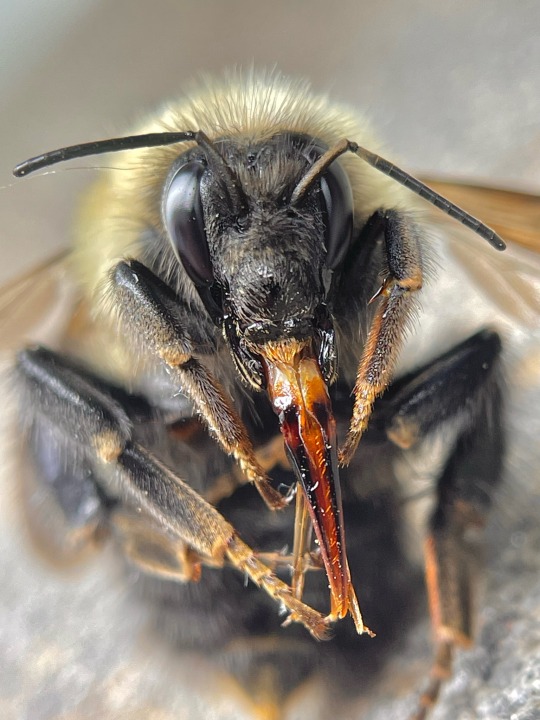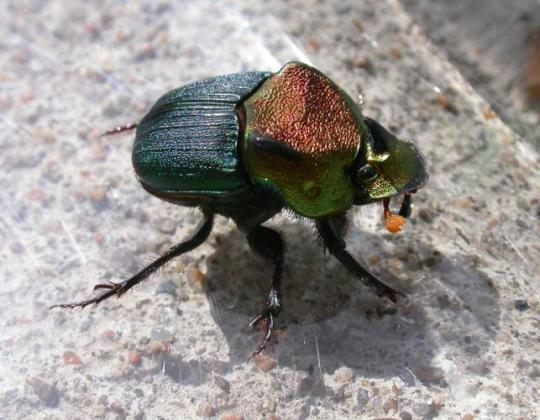#Phanaeus vindex
Text

The Sun
The Sun Card radiates with the brilliance of optimism and enlightenment. It is a symbol of pure, unadulterated joy, casting its golden rays upon a world of boundless possibilities. In its essence, the Sun Tarot Card teaches us the lessons of illumination and clarity, dispelling the shadows of doubt and uncertainty.
Much like the Sun, the rainbow dung beetle stands as a testament to the enduring power of light and positivity in the face of life's trials. This remarkable beetle, adorned with an iridescent sheen, emerges from the hidden depths of dung piles. They tirelessly convert waste into new life, representing the relentless pursuit of purpose and transformation even in less than ideal circumstances. They symbolize the importance of finding value and purpose in what others may deem repugnant or insignificant. Just as the Sun shines its light on all without discrimination, dung beetles play a crucial role in recycling and renewing ecosystems.
Furthermore, the Sun Tarot Card encourages us to embrace our authentic selves, basking in the warmth of self-expression. Dung beetles, too, exhibit authenticity in their unwavering commitment to their role in nature, reminding us that our actions, however modest, can have far-reaching effects. It prompts us to recognize that we are all part of a greater whole, and our well-being is intertwined with the health of our environment.
In essence, the Sun Tarot Card and dung beetles both remind us that even in life's darkest corners or beneath layers of adversity, there exists the potential for growth, joy, and radiant transformation. By embracing our authentic selves and finding purpose in all that we do, we, like the dung beetle, can shine brightly. They urge us to embrace the simple pleasures of life, to bask in the warmth of happiness, and to share our radiance with others. Just as the Sun nourishes life on Earth, our positivity and enthusiasm can nurture the world around us.
Prints available on Redbubble and Inprnt
| Instagram |
#artists on tumblr#illustration#insects#tara jillian art#bugs#nature#redbubbleartist#bug tarot#tarot cards#tarot art#the sun#scarab beetle#dung beetle#rainbow scarab#entomology#phanaeus vindex#big bug gospel#bugblr
1 note
·
View note
Text

Have you ever seen the magnificent rainbow scarab (Phanaeus vindex)? This colorful dung beetle can be found in parts of the eastern and central United States. While most dung beetles are dull shades of brown or gray, this species is one of a handful adorned in striking iridescent colors. Males also sport large horns on their heads! Like other dung beetles, this insect rolls dung into balls to incubate its young. It also digs dung-filled tunnels nearby to ensure that the newborn beetles will have enough to eat.
Photo: Thomas Shahan, CC BY-NC 4.0, iNaturalist
#science#nature#natural history#animals#insects#entomology#did you know#fact of the day#beetles#scarab#rainbow#iridescent#bugs#cool animals
2K notes
·
View notes
Text

a lucky five minutes of walking turned up four beautiful deceased insects!




these four are a two-spotted bumblebee (Bombus bimaculatus) queen (?), a reddish-brown stag beetle (Lucanus capreolus), a broad-necked root borer (Prionus laticollis) and a rainbow dung beetle (Phanaeus vindex), the first I’ve ever seen
the Prionus is missing several parts and the Phanaeus was stepped on, but the other two are pristine. I’ll try to clean up and pin all of them! much more so than killing and pinning live insects, I enjoy fixing up a dusty old dead bug found on the street or in a windowsill. it’s sort of like antique restoration…
959 notes
·
View notes
Text

Rainbow Scarab (Phanaeus vindex)
Habitat & Distribution
Can occupy a range of habitats; most commonly found in pastures and grasslands
Found throughout the continental United States east of the Rocky Mountain Range, down to northern Mexico
Physical Description
Length: 11-22 millimeters (0.4-0.9 inches)
The body is round and stocky, and males have a large horn on their heads
Both males and females have iridescent, primarily green metallic shells, though the shells of females are more dull than males
Adults have wings that are hidden beneath the hard shell when not in use
Behaviour
Rainbow scarabs feed almost exclusively on dung, particularly that of large herbivorous mammals
Adults build extensive subterranean tunnels below food sources, and bury excrement for their larvae to feed on
Unlike other dung beetles, the rainbow scarab shapes faecal matter into pear-shaped balls
Rainbow scarabs are mostly solitary, and males will battle each other to defend their territories
Main predators are birds of prey, including the burrowing owl
Key Advantages
Though they mostly stay on the ground, rainbow scarabs are able to fly over short distances
The irridescent shell may confuse predators
Photo by Julianna Schroeder
84 notes
·
View notes
Text

Rainbow Scarab (Phanaeus vindex), male, family Scarabaeidae, Pennsylvania, USA
a species of "true dung beetle".
photograph by Michael Reed
292 notes
·
View notes
Text

Since everyone liked the first round, more bug fables sketches! But this time with color, especially since I've never seen people acknowledge Kabbu is listed as a Phanaeus vindex in the wiki?? Which means he would be iridescent and extremely vibrant
368 notes
·
View notes
Note
colorfull betles👁👁
Jewel Beetle (Cyphogastra javanica)

scarab beetle, i didnt found the species name

Cetoniinae-Cetonischema

Fiddler beetles (Eupoecila australasiae)

!!!!!! OH THEY'RE SO PRETTY THANK YOU!!!
The closest i could find for the unidentified scarab is the rainbow scarab (phanaeus vindex) female? (a dung beetle!) tho i dont think the mandible is as visible
AAA I love iridescent bugs and I love high contrast!! I think the Cetoniinae-Cetonischema and the green Fiddler Beetle are my favs in this batch but i love them all!!!
#bugs#beetles#i love beetles with their lil grippy paws#asks#beloved moots#beloved basya#thank you aa <33
25 notes
·
View notes
Text

phanaeus vindex
12 notes
·
View notes
Text
Back on my hyperfixation shenanigans so I have not slept and here's a list of what I consider to be the prettiest beetles, butterflies and moths, damselflies, and grasshoppers and crickets that inhabit Colorado and Kentucky according to insectidentification.org :
COLORADO
Emerald ash borer (Agrilus planipennis)
Fifteen-spotted lady beetle (Anatis labiculata)
Golden tortoise beetle (Charidotella sexpunctata)
Knapweed root weevil (Cyphocleonus achates)
Longhorn beetle (Semanotus amethystinus)
Dogbane Leaf Beetle (Chrysochus auratus)
European Ground Beetle (Carabus nemoralis)
Golden Net-wing Beetle (Dictyoptera aurora)?
Margined Blister Beetle (Epicauta funebris)
May Beetle - P. lanceolata (Phyllophaga lanceolata)
Mottled Tortoise Beetle (Deloyala guttata)
Pleasing Fungus Beetle (Gibbifer californicus)
Poplar Borer Beetle (Saperda calcarata)
Shining Leaf Chafer - Anomala spp. (Anomala spp.)
Signate Lady Beetle (Hyperaspis signata)
American Lappet Moth (Phyllodesma americana)
Cinnabar Moth (Tyria jacobaeae)
Common Checkered-Skipper (Pyrgus communis)
Glover's Silkmoth (Hyalophora columbia gloveri)
Great Ash Sphinx Moth (Sphinx chersis)
Autumn Meadowhawk (Sympetrum vicinum)
Black Saddlebags Skimmer (Tramea lacerata)
Bird Grasshopper (Schistocerca spp.)
Obscure Bird Grasshopper (Schistocerca obscura)
Sooty Longwing Katydid (Capnobotes fulginosus)
KENTUCKY
Andrew's Snail-eating Beetle (Scaphinotus andrewsii)
Black Firefly (Lucidota atra)
Calligrapha Beetle (Calligrapha spp)
Eastern Hercules Beetle (Dynastes tityus)
Emerald Euphoria Beetle (Euphoria fulgida)
Glowworm (Phengodes spp.)
Goldsmith Beetle (Cotalpa lanigera)
Metallic Wood-boring Beetle: Chalcophora (Chalcophora fortis)
Notched-mouth Ground Beetle (Dicaelus purpuratus)
One-spotted Tiger Beetle (Apterodela unipuncata)
Rainbow Darkling Beetle (Tarpela micans)
Rainbow Scarab Beetle (Phanaeus vindex)
Six-spotted Tiger Beetle (Cicindela sexguttata)
Southern Sculptured Pine Borer Beetle (Chalcophora georgiana)
Stag Beetle (Lucanus capreolus)
Twice-stabbed Lady Beetle (Chilocorus stigma)
Vietinghoff's Ground Beetle (Carabus vietinghoffii)
Abbott's Sphinx Moth (Sphecodina abbottii)
American Ermine Moth (Yponomeuta multipunctella)
Arched Hooktip (Drepana arcuata)
American Bird's-Wing Moth (Dypterygia rozmani)
Arcigera Flower Moth (Schinia arcigera)
Attentive Crocus Moth (Xanthotype attenuaria)
Basswood Leafroller (Pantographa limata)
Beautiful Wood-Nymph (Eudryas grata)
Black-waved Flannel Moth (Megalopyge crispata)
Blackberry Looper (Chlorochlamys chloroleucaria
Blinded Sphinx Moth (Paonias excaecata)
Bluish Spring Moth (Lomographa semiclarata
Buck Moth (Hemileuca maia)
Carmine Snout Moth (Peoria approximella)
Carrot Seed Moth (Sitochroa palealis)
Cecropia Silk Moth (Hyalophora cecropia)
Changeable Grass-Veneer (Fissicrambus mutabilis)
Colorful Zale (Zale minerea)
Common Lytrosis Moth (Lytrosis unitaria)
Confused Eusarca (Eusarca confusaria)
Cross-lined Wave (Timandra amaturaria)
Curve-toothed Geometer (Eutrapela clemataria)
Dark-banded Geometer (Ecliptopera atricolorata)
Deep Yellow Euchlaena (Euchlaena amoenaria)
Diaphania costata (Diaphania costata
Dimorphic Macalla (Epipaschia superatalis)
Dot-lined White (Artace cribrarius)
Dotted Gray (Glena cribrataria)
Drab Prominent (Misogada unicolor)
Eight-spotted Forester Moth (Alypia octomaculata)
Elder Shoot Borer (Achatodes zeae)
Explicit Arches (Lacinipolia explicata)
Eyed Paectes Moth (Paectes oculatrix)
Falcate Orangetip (Anthocharis midea) (female)
Fall Webworm (Hyphantria cunea)
False Crocus Geometer (Xanthotype urticaria
Fervid Plagodis (Plagodis fervidaria)
Fig Sphinx (Pachylia ficus)
Friendly Probole Moth (Probole amicaria)
Giant Leopard Moth (Hypercompe scribonia)
Goldcap Moss-eater Moth (Epimartyria auricrinella)
Gray-edged Hypena (Hypena madefactalis)
Green Arches (Anaplectoides prasina)
Hag Moth (Phobetron pithecium
Hibiscus Leaf Caterpillar Moth (Rusicada privata)
Imperial Moth (Eacles imperialis)
Lesser Maple Spanworm Moth (Speranza pustularia
Luna Moth (Actias luna)
Melissa Blue Butterfly (Plebejus melissa spp.)
Modest Sphinx Moth (Pachysphinx modesta)
Morbid Owlet Moth (Chytolita morbidalis)
Orange-patched Smoky Moth (Pyromorpha dimidiata)
Pale Beauty (Campaea perlata)
Pale Lichen Moth (Crambidia pallida)
Pale Metarranthis (Metarranthis indeclinata)
Pandorus Sphinx Moth (Eumorpha pandorus)
Parthenice Tiger Moth (Apantesis parthenice)
Pearly Wood-Nymph Moth (Eudryas unio)
Pero Moth (Pero spp.)
Pink-patched Looper (Eosphoropteryx thyatyroides)
Pipevine Swallowtail (Battus philenor)
Pistachio Emerald Moth (Hethemia pistasciaria)
Plebeian Sphinx Moth (Paratrea plebeja) (Caterpillar)
Primrose Moth (Schinia florida)
Promiscuous Angle Moth (Macaria promiscuata)
Raspberry Pyrausta (Pyrausta signatalis)
Rustic Sphinx Moth (Manduca rustica)
Saddleback Caterpillar Moth (Acharia stimulea)
Saddled Yellowhorn (Colocasia flavicornis)
Salt-and-pepper Looper Moth (Syngrapha rectangula)
Satin Moth (Leucoma salicis)
Scarlet-winged Lichen Moth (Hypoprepia miniata)
Schlaeger's Fruitworm Moth (Antaeotricha schlaegeri)
Showy Emerald Moth (Dichorda iridaria)
Small Bird Dropping Moth (Ponometia erastrioides)
Snowy Urola (Urola nivalis)
Sorghum Webworm Moth (Nola cereella)
Southern Flannel Moth (Megalopyge opercularis)
Southern Longhorn Moth (Adela caeruleella)
Southern Pine Sphinx (Lapara coniferarum)
Southern Tussock Moth (Dasychira meridionalis)
The Badwing (Dyspteris abortivaria)
Unspotted Looper Moth (Allagrapha aerea)
Venerable Dart Moth (Agrotis venerabilis
Vine Sphinx Moth (Eumorpha vitis)
Walnut Sphinx Moth (Amorpha juglandis)
Wavy-lined Emerald Moth (Synchlora aerata)
Western Grapeleaf Skeletonizer Moth (Harrisina metallica)
White Flannel Moth (Norape ovina)
White Slant-line Moth (Tetracis cachexiata)
White-fringed Emerald Moth (Nemoria mimosaria)
Yucca Moth (Tegeticula, Greya, and Prodoxus spp.)
Carolina Locust (Dissosteira carolina)
Eastern Shieldback Katydid (Atlanticus spp.)
Slender Meadow Katydid (Conocephalus fasciatus)
True Katydid (Pterophylla camellifolia)
Ebony Jewelwing (Calopteryx maculata)
Midland Clubtail (Gomphurus fraternus)
Red Saddlebags (Tramea onusta)
Seepage Dancer (Argia bipunctulata)
5 notes
·
View notes
Text
Avez-vous déjà vu le magnifique scarabée arc-en-ciel (Phanaeus vindex) ?
See on Scoop.it - Variétés entomologiques
https://www.tumblr.com/chalkandwater/752379501015662592
amnhnyc: “ALTHave you ever seen the magnificent rainbow scarab (Phanaeus vindex)? This colorful dung beetle can be found in parts of the eastern and central United States. While most dung beetle
just another dead rat
------
NDÉ
Traduction
Photo d'un scarabée arc-en-ciel tenu dans une main humaine. L'insecte est puissamment bâti, avec une longue corne sur la tête. Son corps est irisé et présente des nuances de vert, de rouge et de jaune.
Photo : Thomas Shahan, CC BY-NC 4.0, iNaturalist
------
via Taupo sur X, 09.06.2024
"Phanaeus vindex, également connu sous le nom de scarabée arc-en-ciel https://t.co/5T5LdnFloP https://t.co/IXZ4Of6S8b" / X
https://x.com/pierrekerner/status/1799758357420503226
0 notes
Text

bug character for today!! he's one of Sticker's close friends who works at the same post office as them!!
Phanaeus vindex!!


0 notes
Text

look at my best bug fables fanart. here are Vi, Kabbu and Leif at the Golden Festival
#Bug Fables#bug fables spoilers#bug fables kabbu#bug fables vi#bug fables leif#vi#leif#kabbu#bf leif#bf Kabbu#bf vi#team snakemouth#Iotaphora admirabilis#apis mellifera#Phanaeus vindex#my art
724 notes
·
View notes
Photo

Phanaeus vindex (rainbow scarab)
60 notes
·
View notes
Text
Likely a Rainbow Scarab (Phanaeus vindex).
I suggest not picking them up unless you are nearby a location with antibacterial soap, as these beetles make tunnels around feces and feed the dung to their larvae!
31 notes
·
View notes
Text

Scarabs!!!
12 notes
·
View notes
Text



Little Bastard (yes, that is his formal name) was out and about this afternoon right before i left for work!! he’s such a cool little dude, i’m really happy to see him doing well so far. if he keeps eating i might just get him some friends and a bigger enclosure with more room to burrow!
#insects#beetles#bugblr#phanaeus vindex#rainbow dung beetle#i don’t have access to any kind of dung so he’s getting a substitute rn and he’s enjoying it so far!#it was a long shot so i’m glad he seems to like it. he already burrowed away every piece i gave him
8 notes
·
View notes